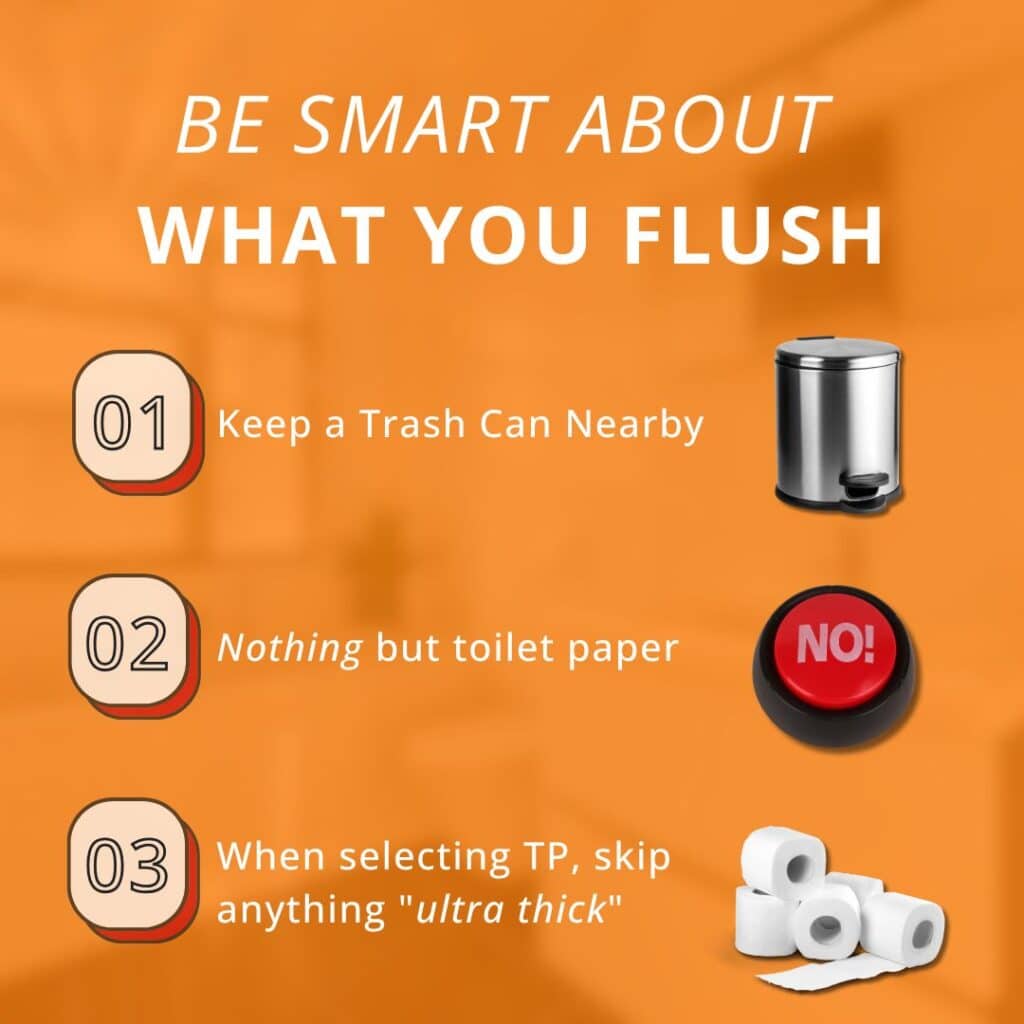Bathroom cleaning is part of every household routine, and if your home uses a septic tank, what you flush, spray, or pour can have a major impact on how well your system works. Septic systems rely on a delicate balance of bacteria to break down waste and process water.
The wrong cleaning products or habits can disrupt that balance, leading to slow drains, clogs, or expensive repairs. If you want to keep your bathroom fresh without harming your septic tank, here’s what you need to know.
Why Cleaning Products Matter
Most store-bought cleaning products are made to kill bacteria, which works well on countertops and toilets, but creates a problem once those chemicals reach your septic tank.
Inside your tank, helpful bacteria work nonstop to break down solid waste. When that bacteria is killed off by harsh chemicals, solids stay intact and start to pile up. This can lead to tank overload, backups, and even system failure.
The more often you use strong cleaners, the more harm they can cause to the system.

Products That Can Hurt Your Septic Tank
Some of the most common cleaning products are also the most damaging. Even though they leave your bathroom looking clean, they can create problems underground.
Avoid flushing or draining the following products:
-
Bleach, especially in toilet bowl tablets
-
Ammonia or ammonia-based sprays
-
Disinfecting wipes, even if labeled “flushable”
-
Drain cleaners that contain lye or acid
-
Harsh tile or grout cleaners
-
Antibacterial hand soaps
These products either kill the helpful bacteria in your tank or introduce chemicals that can slow down the system’s ability to filter water properly.
Better Cleaning Options for Septic Homes
There are septic-safe ways to clean your bathroom that won’t sacrifice results. Look for products that say “biodegradable,” “septic-safe,” or “non-toxic” on the label. These formulas are less likely to upset the balance inside your tank.
You can also use homemade cleaning methods. These tend to be cheaper and gentler on your system.
Try these simple swaps:
-
Mix white vinegar and water for surface cleaning
-
Use baking soda and vinegar for drain cleaning
-
Choose castile soap or diluted dish soap for tubs and sinks
-
Try oxygen-based bleach instead of chlorine bleach for tough stains
You can still keep your bathroom clean and germ-free. It just takes a few tweaks to your routine.
Water Usage and Septic Stress
Cleaning the bathroom usually involves a lot of water. From rinsing the shower to mopping the floor, it’s easy to send large amounts of water down the drain in a short time. This sudden flow can overload your septic tank and slow down processing.
If the tank gets too full too quickly, it may send water out before it’s fully treated. This can cause wastewater to reach your drain field too soon, leading to soggy patches, foul smells, or backups in your home.
Tips to reduce water overload while cleaning:
-
Spread out cleaning tasks instead of doing them all at once
-
Avoid using the washing machine or dishwasher while cleaning the bathroom
-
Fix leaky faucets or running toilets that constantly add water to the system
Being mindful about when and how you use water can help your septic tank keep up without getting overwhelmed.
Items You Should Never Flush
Some cleaning habits can damage your system even faster than chemicals. Flushing the wrong materials is one of the top causes of clogs and tank backups.
Even if something seems small, it may not break down the way toilet paper does.
Never flush:
-
Disinfecting wipes
-
Paper towels
-
Makeup remover pads
-
Cotton swabs or balls
-
Sanitary products
-
Mop water with harsh cleaning chemicals
All of these items belong in the trash, not the toilet. They either clog your pipes or sit in your tank without breaking down, adding strain to your system.

Extra Tips for Septic-Friendly Cleaning
Keeping your bathroom clean doesn’t need to put your septic system at risk. With a few small adjustments, you can maintain both.
Smart habits to adopt:
-
Choose one cleaning day per week to space out chemical and water use
-
Keep trash cans easily accessible in the bathroom to avoid flushing wipes or paper
-
Run water briefly after cleaning to flush diluted chemicals through the system slowly
-
Use septic-safe toilet paper and skip anything labeled “ultra thick”
The goal is to keep things clean while helping your tank stay balanced and efficient.
When to Call a Professional
If you notice slow drains, bubbling in your toilet, or strong smells near your bathroom, your system might already be under stress. It’s better to call in a septic professional before the problem turns into a backup or repair job.
A cleaning routine alone can’t fix a full or damaged tank. Regular inspections and timely pumping are just as important as smart cleaning habits. If it’s been more than three years since your last service, or you’re noticing any warning signs, it’s time to schedule a visit.
Conclusion
Bathroom cleaning and septic tank health are more connected than most people realize. The right cleaning products, smarter water use, and small habit changes can protect your tank and help your system last longer.
To stay ahead of problems, keep an eye on your cleaning routines and how they affect your plumbing. If something feels off or you want help making sure your system is in good shape, reach out to a local septic expert who can take a look and give clear guidance.
